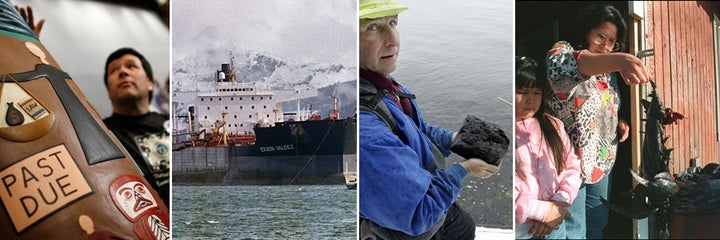
On its 20th anniversary, we all relive the human and environmental tragedy that was the Exxon Valdez oil spill. But today, right now, Alaska faces down another threat that could devastate a $1.5 billion annual salmon fishery, endangered beluga whales, and coastline communities in the most densely populated area of Alaska, from Kodiak to the Kenai Peninsula, to Anchorage, and beyond.
Mt. Redoubt, a volcano which has awakened from slumber after a 20 year period of dormancy, has been erupting for the last few days, shooting ash plumes more than 9 miles into the atmosphere. Lahars (slides of mud, and volcanic debris) are flowing down its flanks in the direction of the shoreline where Drift River feeds into Cook Inlet. This would normally not be an issue of concern. The area is basically unpopulated, and the "Ring of Fire" has been having its way with this area of the world for a very long time. With the exception of some interrupted airline traffic, and 1/4 inch of ash deposited on a few small communities in the Susitna Valley to the north, the volcano hasn't had much impact so far.
The problem comes when you take into consideration that between these lahars, which are filled with train car sized chunks of rock and ice, barreling down the flanks of Redoubt on the one side, and the point at which the Drift River meets the pristine waters of Cook Inlet on the other side is a tank farm. The tank farm is owned by Chevron, and two of the seven tanks contain, at this moment, 6 million gallons of crude oil perched, as it were, between the Devil and the Deep Blue Sea. And the Devil ain't done yet.
So far, Chevron and local media sources are reporting that the tanks "were successfully protected." Past tense. By "successfully protected," Chevron and the media lead us to believe that this is all over. After the near catastrophe at the tank farm in 1989 when Redoubt last erupted, containment walls were built around the tanks, and they have held so far. But, bear in mind, that volcanic eruptions are not predictable things. There have been six major eruptions in the last three days, and the Alaska Volcano Observatory shows Redoubt at "code red," which is just what it sounds like. A major eruption could be imminent.
Photos released by Chevron and a video available on Alaska's KTUU confirm that the volcanic debris has breached the first containment wall, caused significant damage to buildings at the facility, and that there are incursions into the secondary diking system. It doesn't take a geologist, or a petroleum engineer, or a vulcanologist to look at the pictures and see that another major lahar means we're in trouble.
Rumors persist that there is vigorous internal debate at Chevron, discussing whether or not to drain the tanks. In 1989, nobody at Exxon had the luxury of debating whether or not they'd turn the tanker around before it slammed into Bligh Reef, and hemorrhaged 11 million gallons of oil into the previously pristine waters of Prince William Sound. Chevron has that luxury, but may be thinking about the Supreme Court decision this June that let Exxon walk away from the mess with a slap on the wrist two decades later - payment of only three days profit to those whose livelihoods were destroyed. "That's not so bad," Chevron may be thinking.
Redoubt may go back to sleep. It may send debris in another direction. Or it may wipe out a coastal tank farm and dump six million gallons of crude oil into one of the most economically and environmentally valuable bodies of water since....well....what Prince William Sound used to be. Are we willing to take that chance? The photographic evidence clearly shows us that there is zero room for an error in judgment.
And what is the governor of the state of Alaska doing about this? Well, so far, nothing. A look at the most recent press releases on the State of Alaska website reveals she's been concentrating more on the "Latest Bogus Ethics Complaint", and commenting on the "President's Remarks on Leno" than stepping up to the plate and demanding that Chevron drain their tanks, and get the oil out of harms way.
Perhaps it's time to help Governor Palin prioritize, and urge her to listen to Cook Inletkeeper and citizens who are calling on Chevron to draw down the oil in the tanks.
"Worker safety is paramount, and we need to ensure the oil can be removed in a safe and orderly fashion," said Bob Shavelson, executive director of Cook Inletkeeper. "But we never knew Chevron planned to keep 6 million gallons of crude at the base of an erupting volcano until yesterday, because Chevron kept hiding behind the façade of Homeland Security."
Public agencies responsible for the safe and legal operation of the Drift River terminal include the U.S. Coast Guard, the U.S. Environmental Protection Agency, the Alaska Department of Environmental Conservation and the Alaska Department of Fish & Game.
